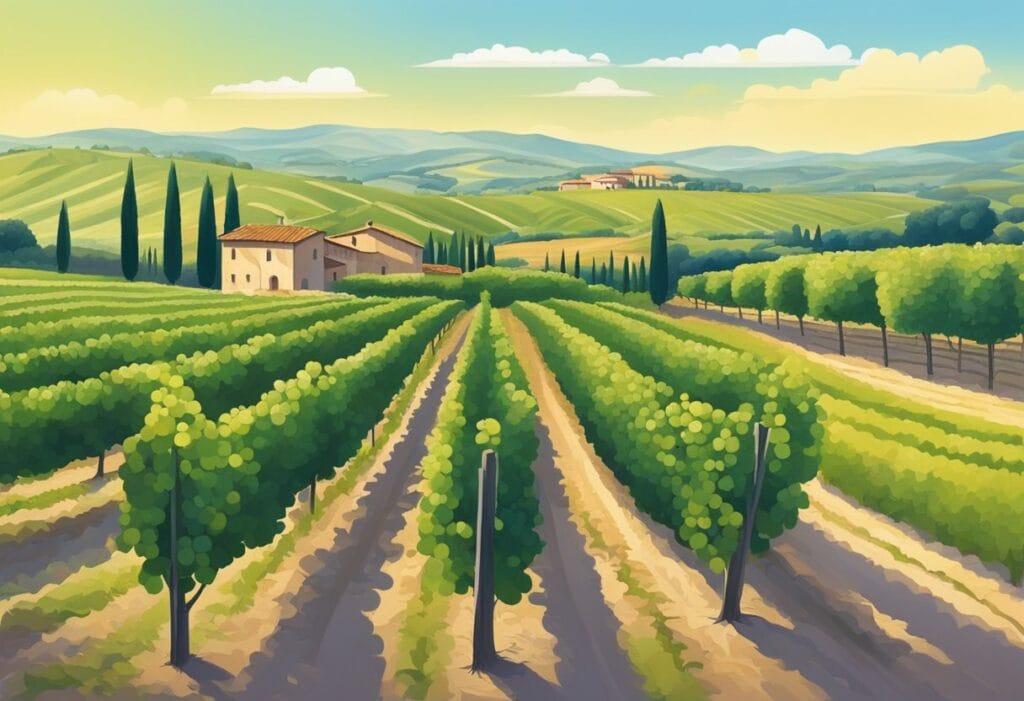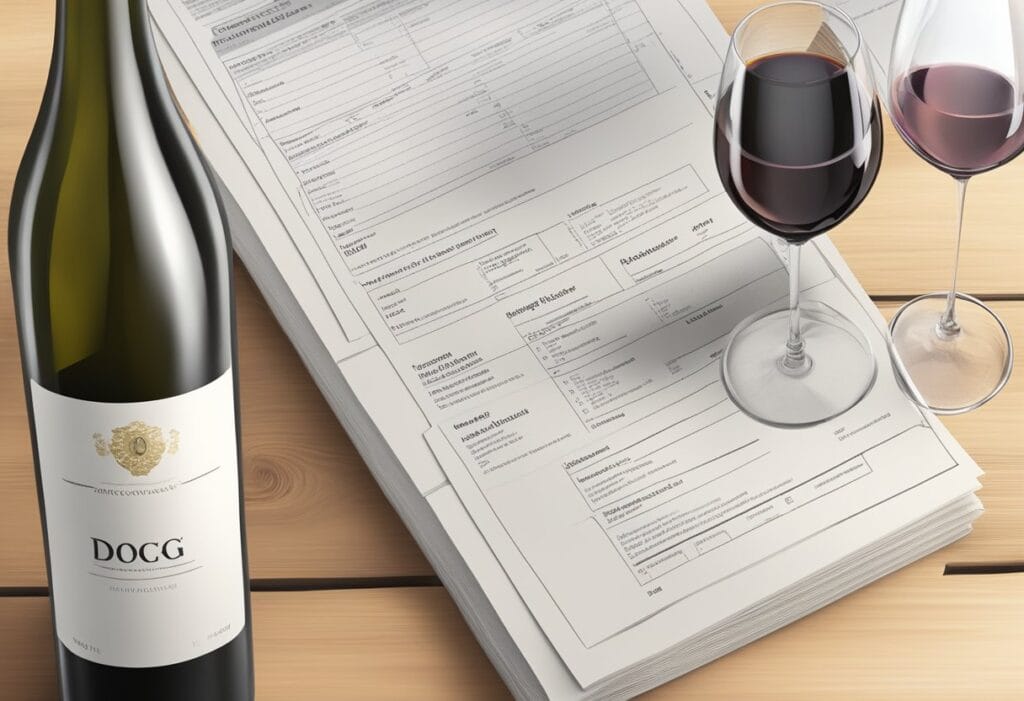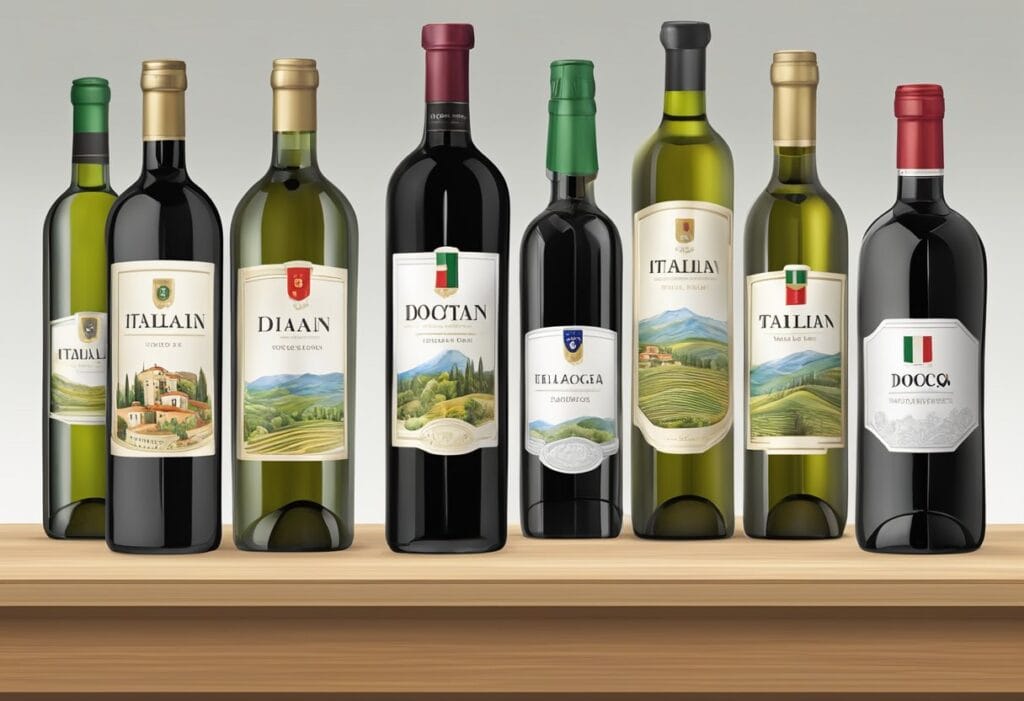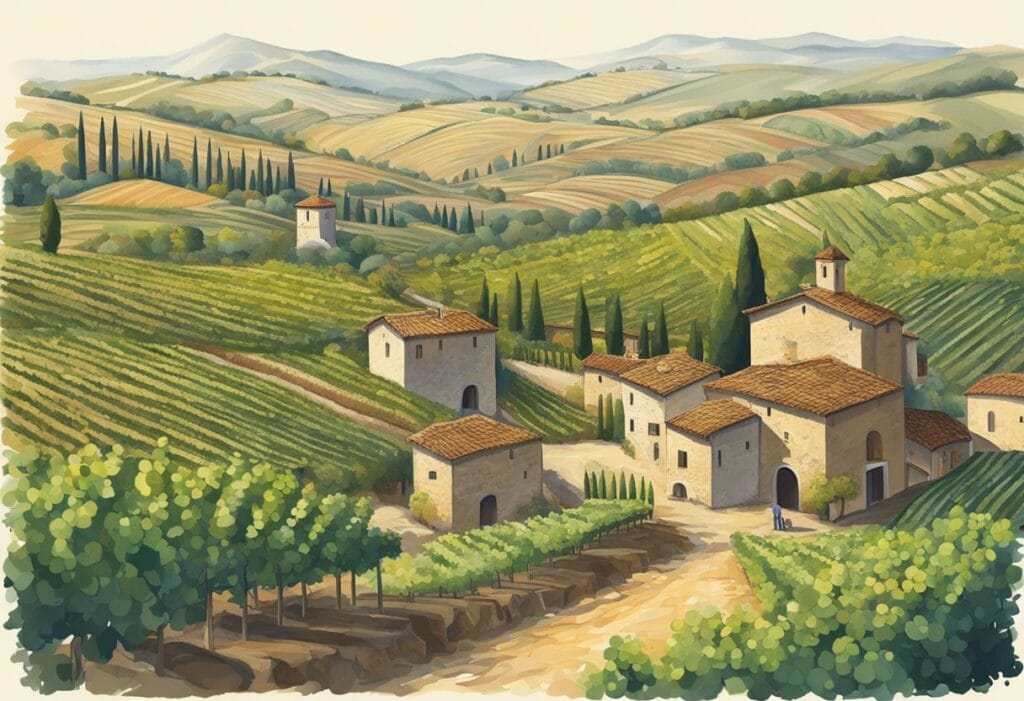The Italian DOCG classification stands as the pinnacle of Italy’s wine quality pyramid, designed to celebrate and protect the country’s most prestigious vinicultural treasures. Standing for Denominazione di Origine Controllata e Garantita, this label is a testament to the highest standards of winemaking.
When you see DOCG on a bottle, it signifies adherence to stringent regulations regarding the grape variety, yield limits, winemaking practices, and often a guarantee of origin through a taste test by a government-licensed panel.

This classification not only marks a wine’s geographic authenticity but also its compliance with approved cultivation and production techniques unique to the specific region.
Each DOCG wine region has its own set of rules and traditions that winemakers must follow, making the taste of each wine a true representation of its origin. The labeling and presentation are carefully controlled to ensure that when you select a DOCG wine, you’re experiencing a piece of Italian winemaking heritage.
Key Takeaways
- DOCG label ensures top quality and regulated production.
- Compliance with specific regional winemaking rules is mandatory.
- Labeling conveys the wine’s authenticity and origin.
Historical Context of Italian Wine Classifications
Italian wine classifications stand as a testament to the country’s dedication to preserving the quality and tradition of its wines. The Denominazione di Origine Controllata and Denominazione di Origine Controllata e Garantita are cornerstones of this system, rooted in a complex historical tapestry.
Origins of DOC and DOCG
The classification system for Italian wines was instituted to maintain the high standards that are synonymous with the country’s rich winemaking heritage. Denominazione di Origine Controllata (DOC), introduced in 1963, marked a pivotal moment, establishing regulations that strictly governed wine production. Its purpose was to preserve regional traditions and assure customers of the quality of wines originating from specific locales within Italy.
Building on these foundations, Denominazione di Origine Controllata e Garantita (DOCG) was later created to identify the pinnacle of quality within Italian wines. The initiation of DOCG recognized that certain wines exceeded the already stringent DOC requirements, meriting an even higher classification. To attain DOCG status, wines undergo rigorous analysis which includes government-sanctioned tasting by a panel of experts.
Evolution of Wine Quality Standards
Over time, the Italian government has played a critical role in overseeing and adapting these wine classifications to uphold standards and protect the integrity of the nation’s wine heritage. The evolution of quality standards is not only a reflection of the growing sophistication in winemaking practices but also a response to the market’s increasing demand for authentic and high-quality products.
As winemaking techniques advanced through the centuries, from monastic vineyards of the past to modern-day viniculture, the classification system continually adapted.
It responded to the need for more nuanced categories, as seen with the introduction of Indicazione Geografica Protetta (IGP) and other tiers addressing regional uniqueness and quality variance.
Through tradition and regulation, Italy’s Wine Classification System ensures that each bottle carrying the DOC or DOCG seal represents the area’s character and the rigorous standards set by the government. This interlacing of history, tradition, and regulations echoes through the wine culture of Italy.
Understanding DOCG
When exploring Italian wines, you’ll encounter the Denominazione di Origine Controllata e Garantita (DOCG), the highest classification guaranteeing quality and authenticity.
Criteria for DOCG Status
To achieve DOCG status, a wine must adhere to strict quality parameters. This includes the grape variety, yield limits, winemaking procedures, and aging requirements. Each wine is also subject to a rigorous analysis and tasting by government-approved personnel to ensure it meets the highest possible standards.
The Importance of DOCG for Winemakers
Winemakers value the DOCG label as it not only stands for the pinnacle of quality but also serves as a strong marketing tool. It establishes a sense of prestige and suggests a guarantee of the wine’s origin and quality, as it must come from a specified region known for its unique terroir.
Impact on Consumer Perception
For consumers, the DOCG label is a marker of authenticity and assurance that the wine they are purchasing is of high quality. It guides them through the rich landscape of Italian wines ensuring the product is from a specific, government-recognized region.
DOCG Wine Regions

The “Denominazione di Origine Controllata e Garantita” (DOCG) is the highest designation for Italian wines, ensuring strict quality and geographic origin.
Piedmont’s Renowned Varietals
In Piedmont, you will find some of the most prestigious DOCG wines. Notably, Barolo and Barbaresco are the stars of this region. Barolo, often described as one of Italy’s greatest wines, is made from the Nebbiolo grape and is known for its rich flavors and ability to age.
Similarly, Barbaresco is also made from Nebbiolo and is highly regarded for its elegant aroma and finesse. Explore the intricacies of these wines and their production process through European wine regions and traditions.
Tuscany’s Prestigious Wines
Moving to the heart of Tuscany, you’ll discover another constellation of esteemed DOCG wines. Brunello di Montalcino, a robust red made from Sangiovese, stands out for its longevity and rich character. The Chianti class, particularly from the Chianti Classico zone, is also under the DOCG umbrella, embodying the Tuscan winemaking heritage with its ruby red color and savory taste.
The Consorzio per la Tutela dei Vini DOC Bolgheri e DOC Bolgheri Sassicaia underscores the region’s commitment to maintaining high standards for these distinguished wines.
Other Prominent DOCG Regions
Beyond Piedmont and Tuscany, other regions also contribute to Italy’s DOCG portfolio. Veneto, Abruzzo, and Emilia-Romagna are regions where you’ll encounter additional DOCG classified wines. Each region has its signature varietals, which have surpassed stringent regulations to garner the DOCG label, embodying the excellence of Italian viticulture.
DOCG Regulatory Framework

The Denominazione di Origine Controllata e Garantita (DOCG) represents the highest level of quality for Italian wines, involving strict regulations overseen by the Italian Government and enforced by various consortia.
Role of the Italian Government
Your understanding of the DOCG regulatory framework starts with the role played by the Italian Government. It is responsible for establishing the guidelines that define the conditions under which a wine can be classified as DOCG.
These regulations specify various aspects, including the geographic zone, permitted grape varietals, and yield limits. Additionally, the government’s involvement ensures the preservation of traditional winemaking practices synonymous with Denominazione di Origine.
Consortium’s Responsibilities
For a wine region to maintain its DOCG status, a consortium, such as the Consorzio per la Tutela dei Vini DOC Bolgheri e DOC Bolgheri Sassicaia, is often developed. These consortia have the power to further refine and enforce the rules. Their responsibilities include monitoring the adherence to set quality controls and overseeing the promotion and protection of the region’s wine reputation. This active governance ensures every bottle reflects the area’s distinct character.
Control and Enforcement Measures
Control and enforcement measures are central to maintaining the integrity of DOCG wines. Strict protocols are in place starting from the vineyard to the store shelf. An intricate labeling system identifies the wine’s authenticity, with each bottle bearing a unique serial number.
These measures ensure that when you purchase a DOCG wine, you receive a product of certified quality and origin, meeting the highest standards set by Italian wine classification systems, akin to systems like the French AOC.
DOCG Labeling and Presentation

When you encounter a bottle with a Denominazione di Origine Controllata e Garantita (DOCG) label, you’re looking at Italy’s highest tier of quality assurance in wine. This classification ensures that the wine meets strict regulations from grape cultivation to wine making.
Understanding DOCG Labels
DOCG labels are a guarantee of quality and origin. They signal that the wine adheres to precise standards set for specific regions in Italy. On a DOCG wine label, you’ll find the name of the controlled designation and often additional information on the grape variety and vintage. The Denominazione di Origine part of the label assures you that the wine producers followed rigorous methodology and it was produced within the designated region.
- Name of the Designated Region: Underlines the geographical origins.
- Grape Variety: Indicates which grapes were used.
- Vintage: The year the grapes were harvested.
- Quality Indicators: Terms like “Riserva” suggest additional quality measures.
Marketing DOCG Wines
When marketing DOCG wines, emphasizing their quality and guarantee of origin is essential. These wines have undergone strict regulatory scrutiny to ensure the highest standards of wine production. As a consumer, you should look for the official DOCG seal, which is typically found on the bottle’s neck. This seal is not only a mark of excellence but also a tool that helps prevent counterfeit products.
- Official DOCG Seal: Confirms authenticity.
- Classifications: Helps in distinguishing the quality of wine.
Remember, the presentation is paramount with DOCG wines. It imparts to you a sense of the tradition, care, and expertise that went into creating each bottle.
Cultivation and Production Techniques

In the realm of Italian wines, DOCG classifications mark the pinnacle of quality and tradition. Your understanding of these prestigious standards begins with the intricacies of cultivation and production techniques that each vineyard must adhere to faithfully.
Grape Varieties and Terroir
Grape Varieties are selected with precision to reflect the region’s historical and geological character, known as the Terroir. For a wine to meet DOCG standards, it must be produced from specified grape varieties that thrive in the delimited area. For instance, the revered Nebbiolo grape is central to the Barolo DOCG, leveraging the unique terroir of Piemonte to produce its distinctive taste and aroma.
Harvesting and Yield Regulations
When you sip a glass of DOCG wine, remember that its harmony of flavors is partly due to strict yield regulations designed to concentrate the wine’s quality. Harvest Yields are meticulously controlled; only a certain quantity of grapes can be harvested per hectare to ensure that each grape contributes the maximum intensity of flavor.
Riccardo Binda, an expert in Italian viticulture, emphasizes the importance of these regulations in maintaining the high-quality standard DOCG wines are renowned for.
Aging and Vinification Processes
The measure of a wine’s character comes through in its Aging and Vinification Processes. The DOCG seal guarantees that the wine you enjoy has been aged for a minimum prescribed period, whether in oak barrels or in the bottle. This step is crucial for allowing the complex flavors and aromas to develop.
Additionally, specific vinification techniques are employed to enhance the inherent qualities of the grapes, often adhering to time-honored traditions that reflect the region’s winemaking heritage.
Challenges and Controversies

In the world of Italian wines, the Denominazione di Origine Controllata e Garantita (DOCG) represents the highest quality designation, but its criteria and distinction from Denominazione di Origine Controllata (DOC) often spark debate and controversy. Let’s examine the issues that typically arise within these classifications.
Debates Over DOCG Criteria
Critics argue that the DOCG criteria, intended to ensure the highest quality and tradition, can sometimes hinder innovation. They suggest that the rules may be too rigid, stifling the creativity of winemakers by placing a heavy emphasis on adherence to traditional methods and local food pairing. While the regulations aim to preserve quality and heritage, concerns about their impact on progressive techniques in winemaking are ongoing.
DOC versus DOCG Distinctions
The distinction between DOC and DOCG is a subject of confusion and contention. DOC, less strict than its counterpart, allows for a broader interpretation of the region’s characteristics, while DOCG’s stringent requirements underscore quality and traditional practices.
However, the question arises whether DOCG classification guarantees superior quality, or if it simply reflects a stricter adherence to process, regardless of the end product’s flavor profile and appeal. This challenges consumers and producers alike to understand the true value and implications of these prestigious labels.

